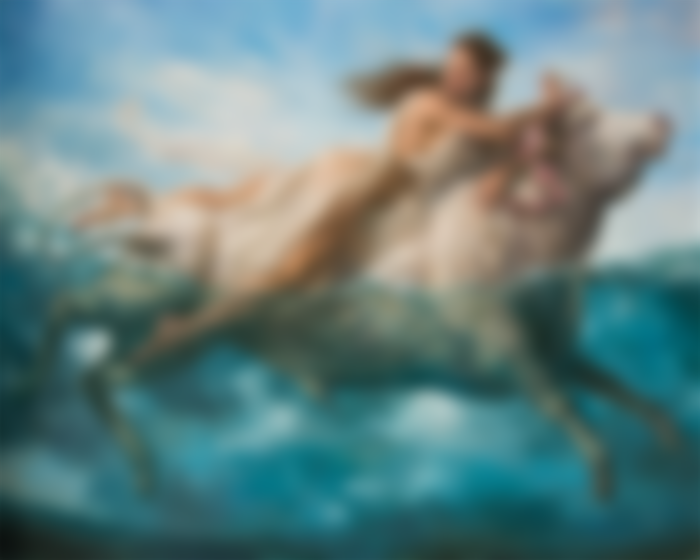Europa-Greek mythology
Europa is a figure from Greek mythology who later gave her name to the continent of Europe. In one popular example of her story, Europa was a Phoenician princess who was kidnapped by Zeus and taken to Crete; King Minos, aka the Labyrinth and Minotaur, would be one of the consequences of Zeus' rape. His investigation by his three brothers may well mirror the historical colonization of the Mediterranean by the Phoenicians from 1200 to 800 BC.

According to Hesiod's Theogony, Europa is the daughter of Ocean and the Titan Tethys (357), while in Homer's Iliad she is the daughter of Phoenix (14:321). In another version of the story, Europa is a Phoenician princess. She is the daughter and brother of the Phoenician King Agenor of Tyre and Phoenix.
This is the version of events presented by the 5th century BC historian Herodotus (1.2.1). With a somewhat strange courtship tactic, Zeus either transformed himself into a white bull or sent a handsome bull to impress the princess. Europa was actually fascinated by the docile beast and adorned it with flowers. Later, thinking he could ride such a kind animal, he climbed onto his back as the bull swam with him into the sea, rose into the air and carried Europa far from Phoenicia.
Flying bulls are perhaps not the best of air carriers, it is not surprising that the bull quickly fell into the sea, and from there the couple swam to Crete. While on the island, Zeus forced himself to the princess, and the couple had three children:
Minos, the future king of Knossos, will become one of the judges of the underworld. wise Rhadamanthys and, in a somewhat later culture, the supreme warrior and ally of Troy, Sarpedon. Although a god often loved and abandoned them, Zeus gave Europa some farewell gifts. There was a hunting dog there that always got its prey; Talos, a personal bouncer, a lively, brave man; and a spear that always hits its target.
Meanwhile, when Agenor realized that his daughter was missing, he sent his three sons to find her again. These were Phoenix, Cilix, and Cadmus, and although they were never able to find their sister, the children (in legend at least) found new colonies in Phenicia, Cilicia, and Boeotian Thebes, respectively. and hence they became the founding fathers of these communities.
The story ends when Europa finds solace in the Cretan king Asterius, whom she later marries and adopts her sons with Zeus. Eventually, the bull that Zeus created became the constellation Taurus. The legend of Zeus, perhaps, who attacked the Phoenician Tyre and carried the treasures back to the island It may have a basis in historical events, representing a true Bronze Age raiding party from Minoan or Mycenaean Crete, or alternatively, it represents an early Hellenic attack on Crete.
The search for Europa and the consequent establishment of colonies reflect the historical reality of Phoenician colonization in the wider Mediterranean between the 12th and 7th centuries BC, which is relatively now confirmed by archaeological evidence.
Name and Book
The name Europa means 'the vast face' and probably refers to the full moon. Alternatively, if the word is split as eu-ip then it means 'well watered'. The ancient Greeks applied the word Europa first to the geographical area of Central Greece and then to all of Greece. By 500 BC Europa represented the entire continent of Europe with Greece at its eastern end (although the Greeks only truly dominated the areas around the Mediterranean).
The Don River in the northern Black Sea was generally considered the border with Asia. Herodotus (4.45) agrees that the continent was known as Europe, but its precise boundaries were unknown and he could not discover why Europa was chosen as the name. Herodotus draws attention to the interesting fact that the Greeks applied three female names to the three large tracts of land they knew, Europe, Asia and Libya.
Europa riding the bull of Zeus was a popular subject in Greek art from the 6th century BC, although the earliest known depiction, an amphora relief, is from the previous century. 6th century BC), a frieze fragment from the Temple of Athena at Athos and a relief plate from Pergamon all show the myth. Black-figure pottery and gems were other means by which the Zeus-European myth was depicted, a very fine example of the former is an Edinburgh painter's amphora now in the Boston Museum of Fine Arts.
A full-figure statue has survived, a copy of an original from the mid-5th century BC, now in the Staatliche Museen in Berlin. Europa is shrouded in a himation cloak, and a smaller version of the figurine inscribed 'Europa' identifies the larger figure as the same subject. The European and bull theme was still popular among red-figure pottery painters in the 4th century BC, especially in Attica and the south of Italy.
The Romans continued to enjoy and perpetuate the legend, and even today the subject remains a favorite and is depicted on the reverse of two modern Greek Euro coins.
